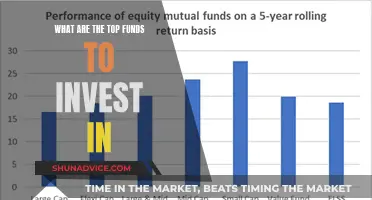
The Social Security trust funds are accounts managed by the US Treasury, which take in payroll taxes from workers and their employers and pay out benefits to recipients. In the past, these funds have been invested in public issues, or marketable securities, but they now hold only special issues – securities available only to the trust funds. These special issues are US government debt securities, which can be redeemed at face value at any time to pay fund obligations. However, some have suggested that these funds should be invested in the stock market instead. This is because the funds are 'rapidly heading to zero', and investing in stocks could lead to higher returns, reducing the need for tax hikes or benefit cuts. However, others argue that investing in the stock market would lead to several issues, including political influence and management fees, and that the funds may not be able to come up with the money to invest while also paying out benefits.
| Characteristics | Values |
|---|---|
| Social Security Trust Funds | Old-Age and Survivors Insurance (OASI) Trust Fund, Disability Insurance (DI) Trust Fund |
| Management | Department of the Treasury |
| Investment Type | Special issues (only available to trust funds), public issues (available to the public) |
| Investment Risk | Low |
| Investment Returns | Low |
| Solvency | Expected to be able to pay full benefits until 2035 |
What You'll Learn

Political influence and market interference
If the US government were to invest in the stock market, it would become a significant player, with the potential to influence corporate decision-making and stock market trends. This could distort the market and create an uneven playing field for private investors and wealth managers.
Additionally, there is a risk that political considerations could influence investment decisions. While safeguards could be put in place to mitigate this, such as granting the government a passive role or requiring it to follow fiduciary standards, there would still be a perception of political interference.
Furthermore, any investments would incur management fees, and the reduction in general revenues from redirecting social security funds could require increased taxation or borrowing, potentially offsetting any macroeconomic benefits.
These concerns about political influence and market interference have been raised in discussions about investing social security funds in equities, and they are important factors to consider when evaluating the potential risks and benefits of such investments.
Hedge Fund Insights: EDGAR Investment Info Source
You may want to see also

Management fees
One key factor often overlooked in these comparisons is the cost of risk associated with investing in the stock market. The stock market offers higher average returns but also carries greater risk, and this risk must be factored into any analysis of rates of return. The Congressional Budget Office (CBO) and the Office of Management and Budget (OMB) agree that the cost of this added risk must be incorporated, and when it is, the difference in returns disappears.
Additionally, private accounts can lead to higher administrative costs, which eat into the payroll tax revenues that have been diverted to these accounts. The Social Security system has relatively low administrative costs, currently at 0.7% of total expenditures. In contrast, the administrative costs of managing numerous private accounts could reduce benefit payouts, resulting in slightly lower rates of return than the current system.
Furthermore, the transition to private accounts would incur heavy transition costs. Social Security is a pay-as-you-go system, where current payroll taxes are used to pay current beneficiaries. If some of these taxes are redirected into private accounts, additional revenue sources are needed to continue paying current retirees. These transition costs could be funded by cutting benefits for current retirees, increasing taxes, or borrowing, all of which would negate the supposed benefit of higher returns from private accounts.
In summary, while proponents of private accounts argue for higher rates of return, these claims are invalidated when the costs of risk, administrative fees, and transition costs are considered. These management fees and expenses highlight why investing social security funds in private markets is not a straightforward solution and why the current system, with its low administrative costs, remains a more secure option.
Real Estate Fund Investing: What You Need to Know
You may want to see also

Increased taxation or borrowing
The US Social Security Trust Fund is facing a long-term financial shortfall, and one proposal to address this is to increase taxes. This could involve raising the FICA tax, which is a payroll tax on income below an annual cap, or introducing new payroll taxes for higher earners. For example, Joe Biden's campaign platform initially proposed new payroll taxes for those earning over $400,000 per year, although this was later changed to include only Medicare tax changes.
Another option is to borrow money to invest in stocks, private equity, or other instruments that offer higher expected returns than interest on government debt. However, this proposal has been criticised as no more sensible than an individual taking out a large loan and putting it in the stock market.
If the trust fund runs a surplus, the money can be invested in US treasuries and used to offset other debts or taxes. However, if the fund runs a deficit, Congress may need to allocate additional funds to pay out benefits. This could be achieved through increased taxation or borrowing.
One argument against investing Social Security funds in the stock market is that the reduction in general revenues would require increased taxation or borrowing, which would largely offset any macroeconomic benefit.
Robo Advisors: Index Fund Investing Strategies Explored
You may want to see also

Risk and uncertainty
One of the main risks associated with investing social security funds in the stock market is the potential for adverse effects on the stock market and corporate decision-making. Critics argue that government involvement in the stock market could lead to political influence and interference in private markets. Additionally, any investments would incur management fees and compete with private wealth managers and investors. Furthermore, the reduction in general revenues resulting from redirecting social security funds towards stock market investments could require increased taxation or borrowing, potentially offsetting any macroeconomic benefits.
Another concern is the risk associated with equity investments themselves. Stocks are generally riskier than government securities, and the additional risk borne by stocks is compensated by the equity premium. Policymakers need to assess the level of additional risk, who will bear this risk, and whether the potential benefits outweigh the increased risk. Moreover, there is no guarantee that historical rates of return on equities will continue in the future. Stock market prices are currently extremely high, and financial economists forecast future equity premiums to be lower than the postwar mean. Therefore, investing social security funds in the stock market may not provide the expected returns and could lead to potential losses.
The risk of early bankruptcy also needs to be considered. While simulations suggest that investing a portion of the social security trust fund in equities may only slightly increase the probability of bankruptcy before the projected date, there is still a chance that extreme events, such as very low returns, could occur. Additionally, proposals that include guaranteed minimum benefits for individuals could further strain the system, as taxpayers would ultimately bear the downside risk in the event of a sustained drop in the stock market.
In conclusion, while investing social security funds in the stock market may offer the potential for higher returns, it also introduces risks and uncertainties that need to be carefully evaluated. Policymakers must weigh the potential benefits against the additional risks involved and consider the impact on the overall stability of the social security system.
Bond Funds vs Individual Bonds: Pros and Cons for Investors
You may want to see also

Historical rates of return
Caldwell et al. (1998) compute internal rates of return on contributions for several categories of Old-Age and Survivor's Insurance (OASI) participants. They find that, under current OASI rules, today's lowest-paid workers can expect internal rates of return between 4% and 5% after adjusting for inflation. Today's middle-income workers can expect real rates of return between 1% and 2%, while today's highest-paid workers can expect real rates of return below 1% and may even face negative rates of return if born after 1975.
Gustman and Steinmeier (1998) find that immigrants receive a higher rate of return on Social Security contributions in comparison to US-born workers, even when their earnings are identical for all years the immigrant has been working in the US. This is because Social Security's benefit formula assigns a value of zero earnings to all years the immigrant spends outside the US.
In 2023, the Social Security trust funds earned an effective interest rate of 2.4%, while the average of the 12 monthly rates for the debt they purchased that year was 4.1%. In May 2024, the interest rate for new special issue debt bought by the Social Security trust funds was 4.750%.
Overall, it is difficult to provide a definitive historical rate of return for Social Security contributions due to the complex and individualised nature of the Social Security system. However, the studies presented here suggest that, while lower-income workers may receive a positive rate of return, higher-income workers may receive a very low or even negative rate of return on their contributions.
Vanguard's Anti-Gun Investment: Funds for a Safer Future
You may want to see also
Frequently asked questions
Investing Social Security funds in the stock market would introduce additional risk to the system. Stocks are riskier than government securities, and while they have the potential for higher returns, there is no guarantee that this will be the case.
There are three options to prevent a Social Security funding shortfall: 1) increase revenues by raising the payroll tax and the earnings cap, 2) reduce benefits, and/or 3) increase the rate of return on funds in the Social Security Trust.
There are two types of Social Security Trust Funds: the Old-Age and Survivors Insurance (OASI) Trust Fund and the Disability Insurance (DI) Trust Fund.







